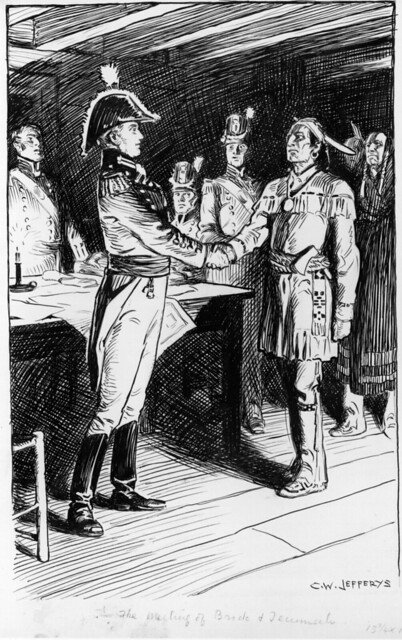
To help mark the War of 1812’s bicentennial year, staff from the Archives of Ontario will be posting a series of articles highlighting their related collections. Their records on the war document battles and battlefields and offer first-person accounts on what life was like during this time. Documentary art and illustrations — samples of which you’ll see in these posts — also show us the landscapes of the day and how much our spaces have changed since then.
![]()
The road to war
By Christine Kowbuz (Records Analyst, Archives of Ontario)
The population of Upper and Lower Canada in 1812 included communities of German, Scottish, Irish, Dutch, and French Canadians. After the American War of Independence (1775 to 1783), 50,000 British Loyalists fled to the Canadas as loyalty to Britain was then a crime in the U.S. Formerly enslaved people who had fought for the British were promised freedom in Canada and settled here. Some First Nations looked to British and Canadian support to help preserve their culture and lands that were slowly being destroyed by American expansion.
Why did America declare war on Upper and Lower Canada? America was a neutral nation but was burdened with trade restrictions because of the British war with France. American sailors were subject to impressments by the Royal Navy and being forced to serve Britain. The British supported the unification of First Nations and saw them as allies to Canada; America was intimidated by the resistance of its native peoples. And as a growing country, America wanted to expand into Canada.
Thinking it was an easy venture, American President James Madison declared war on Canada on June 1st, 1812 with the actual conflict starting on June 18th.
 Canada and America were at war for over two years. The main theatres took place in Detroit and Lake Erie, the Niagara Frontier and York, and Kingston and St. Lawrence, with Naval battles on the Great Lakes. The war officially began on July 12th, 1812 when American General William Hull and 1,000 men crossed the Detroit River to what is now Windsor.
Canada and America were at war for over two years. The main theatres took place in Detroit and Lake Erie, the Niagara Frontier and York, and Kingston and St. Lawrence, with Naval battles on the Great Lakes. The war officially began on July 12th, 1812 when American General William Hull and 1,000 men crossed the Detroit River to what is now Windsor.
Hull and his men later retreated and surrendered in Detroit to Major General Sir Isaac Brock and Shawnee Chief Tecumseh. A second invasion took place on the Niagara Peninsula but the Americans were again defeated at the battle of Queenston Heights where General Brock was killed.
Stay tuned for posts on how the Archives of Ontario’s collections can deepen our understanding of this fascinating time in our history. To learn more, visit our website at ontario.ca/archives.
Images:
TOP:
Artist: JEFFERYS, CHARLES WILLIAM (C.W.)
Title: The Battle of Lundy’s Lane
Date: c. 1921
Medium: pen and ink, heightened with Chinese white
Dimensions: 29.2 x 36.8 cm
Category: work on paper
Accession #: 621234
BOTTOM:
Artist: JEFFERYS, CHARLES WILLIAM (C.W.)
Title: The Meeting of Brock and Tecumseh
Date: c. 1921
Dimensions: 36.8 x 29.2 cm
Category: work on paper
Accession #: 621231



